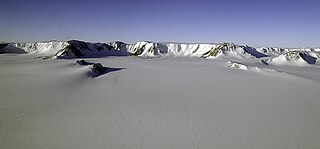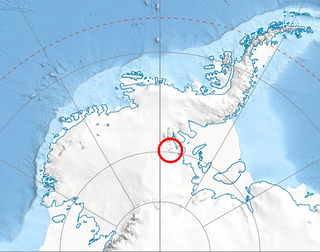Related Research Articles

The Shackleton Range is a mountain range in Antarctica that rises to 1,875 metres (6,152 ft) and extends in an east–west direction for about 100 miles (160 km) between the Slessor and Recovery Glaciers.

The Byrd Glacier is a major glacier in Antarctica, about 136 km (85 mi) long and 24 km (15 mi) wide. It drains an extensive area of the Antarctic plateau, and flows eastward to discharge into the Ross Ice Shelf.

The Churchill Mountains is a major range of mountains and associated elevations bordering the western side of the Ross Ice Shelf, between Byrd Glacier and Nimrod Glacier. They are south of the Britannia Range and north of the Geologists Range, Miller Range and Queen Elizabeth Range.
The Amundsen Glacier is a major Antarctic glacier, about 7 to 11 km wide and 150 km (80 nmi) long. It originates on the Antarctic Plateau where it drains the area to the south and west of Nilsen Plateau, then descends through the Queen Maud Mountains to enter the Ross Ice Shelf just west of the MacDonald Nunataks.

The Usarp Mountains are a major mountain range in North Victoria Land, Antarctica. They are west of the Rennick Glacier and trend north to south for about 190 kilometres (118 mi). The mountains are bounded to the north by Pryor Glacier and the Wilson Hills. They are west of the Bowers Mountains.

Mount Shattuck is a peak, 1,430 m, located at the south end of Independence Hills, about 3 miles (4.8 km) northwest of Redpath Peaks, in the Heritage Range. It was named by the Advisory Committee on Antarctic Names (US-ACAN) for aviation machinist Wayne M. Shattuck of the U.S. Navy, who was an air crewman on LC-47 aircraft, who perished in a crash on the Ross Ice Shelf on February 2, 1966.
Surveyors Range is a 30 miles (48 km) long mountain range in the Churchill Mountains of Antarctica.

The Independence Hills are a line of rugged hills and peaks, 10 miles (16 km) long, with mainly bare rock eastern slopes. They lie 3 miles (5 km) southeast of the Marble Hills and form the southern segment of the west wall of Horseshoe Valley, in the Heritage Range of Antarctica. The Independence Hills were mapped by the United States Geological Survey from ground surveys and U.S. Navy air photos, 1961–66. The name was applied by the Advisory Committee on Antarctic Names in association with the name "Heritage Range".
Beitzel Peak is a peak, 2,170 metres (7,120 ft) high, rising 1.5 nautical miles (3 km) southeast of Minaret Peak in the Marble Hills, Heritage Range. It was named by the Advisory Committee on Antarctic Names for John E. Beitzel, a geophysicist on the United States Antarctic Research Program South Pole—Queen Maud Land Traverse I and II, 1964–65 and 1965–66.
The Butler Glacier is a broad glacier draining the north side of Edward VII Peninsula in the vicinity of Clark Peak, and flowing generally northeastward through the Alexandra Mountains to its terminus in Sulzberger Bay.
The Carlstrom Foothills are a group of peaks and ridges in the Churchill Mountains, Antarctica.
Welch Mountains is a group of mountains that dominate the area, the highest peak rising to 3,015 metres (9,892 ft), located 25 nautical miles north of Mount Jackson on the east margin of the Dyer Plateau of Palmer Land, Antarctica
Pojeta Peak is a peak rising to about 1,500 m in the central part of Webers Peaks, 2 nautical miles (3.7 km) southeast of Bingham Peak, in the Heritage Range, Ellsworth Mountains, Antarctica. It was named by the Advisory Committee on Antarctic Names (US-ACAN) after John Pojeta, Jr., a United States Geological Survey (USGS) paleontologist from 1963 and a field party member and paleontologist with the United States Antarctic Research Program (USARP) Ellsworth Mountains Expedition of 1979–80.
Gliozzi Peak is a peak, 1,475 metres (4,840 ft) high, standing 3 nautical miles (6 km) south of Plummer Glacier in the Douglas Peaks of the Heritage Range, Antarctica. It was named by the Advisory Committee on Antarctic Names for James Gliozzi, a glaciologist on the United States Antarctic Research Program South Pole—Queen Maud Land Traverse I of 1964–65.
Hudak Peak is a peak rising to 1,440 metres (4,720 ft) immediately south of Plummer Glacier in the Douglas Peaks of the Heritage Range, in the Ellsworth Mountains of Antarctica. It was named by the Advisory Committee on Antarctic Names in 2004 after Curtis M. Hudak, a geologist on the United States Antarctic Research Program 1979–80 Ellsworth Mountains expedition.
Starshot Glacier is a glacier 50 nautical miles (90 km) long that flows through the Churchill Mountains to enter the Ross Ice Shelf in Antarctica.

The Kent Plateau is an ice-covered plateau in the northern extreme of the Churchill Mountains of Antarctica.
The La Gorce Mountains are a group of mountains, 20 nautical miles long, standing between the tributary Robison Glacier and Klein Glacier at the east side of the upper reaches of the Scott Glacier, in the Queen Maud Mountains of Antarctica.
The Allegheny Mountains are a small group of mountains 10 nautical miles west of the Clark Mountains in the Ford Ranges of Marie Byrd Land, Antarctica.
References
 This article incorporates public domain material from "Redpath Peaks". Geographic Names Information System . United States Geological Survey.
This article incorporates public domain material from "Redpath Peaks". Geographic Names Information System . United States Geological Survey.
